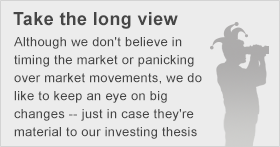Filed under: Investing
It's no secret that Google makes its living from advertising, both display and search-related. How much of Google's $15.42 billion in revenue generated in the recently completed 2014 first quarter is attributable to search? That's not something CEO Larry Page chooses to share, but it's safe to say Google search still drives a significant portion of overall sales.
Research firm eMarketer estimates that Google will earn $15 billion in net search advertising revenue this year, a jump of about $1 billion from 2013. Yahoo! earned over one-third of its $1.13 billion in revenue last quarter from search. And the ancillary revenues derived from search likely make up an even bigger portion of each search giant's total advertising pie. But what if online search started to decline drastically, or, worse yet, disappear altogether?
What's the problem?
The long-term concern is the growing number of online users who are shifting from desktops to all-in-one mobile devices. Mobile users don't use search as often as PC users, they're too busy running their apps. According to one mobile industry pundit, on average Android smartphone users search the Internet with a browser, such as Google or Yahoo!, a mere 1.25 times daily.
Though Yahoo! was able to buck the declining search revenue trend last quarter compared to its 2013 first quarter -- sending it up 5% to $445 million on a generally accepted accounting principles basis -- CEO Marissa Mayer can read the writing on the wall. Not only is Yahoo! aggressively building out its content offerings in an effort to transform itself into a destination site, in addition to a portal like Google, both companies are laser-focused on boosting their respective suite of mobile solutions.
According to eMarketer, Google's new mobile-friendly enhanced campaigns -- which essentially force advertisers to go mobile if they want to bid on desktop ads -- as well as product listing advertising alternatives, are helping to offset the trend of fewer mobile searches. Product listings include pictures and are historically more effective for Google's advertisers.
But neither Google nor Yahoo! are out of the woods, and both think they've found the solution. This shouldn't be surprising considering Mayer's history as the head of Google's products division a few years back.
The solution
A steady drop in mobile search should spell big trouble for the two search giants, right? It would, except for something called "context," or what Mayer referred to in 2010 while with Google as "contextual discovery." According to Mayer four years ago, contextual discovery was "a little like getting search results without having to actually perform the search." Though she's since updated her term to contextual search, the concept's the same. With so much data at the fingertips of these search giants, the idea is to provide you with the information you need, before you ask for it.
Mayer cited a couple of examples, including your smartphone automatically loading the menu of a restaurant you just arrived at, without requiring a search of the web. That was four years ago, and Mayer still loves the idea. At a tech conference a few months ago, Mayer echoed her same theme from 2010 regarding context.
Not surprisingly, Google has been hard at work developing the right way to substitute mobile context for search, too. Google introduced a watered-down version of context search when it rolled out its voice recognition search a year ago. But a lot has changed in the past year, which is confirmed by last year's hands-free "upgrade," which Google targeted exclusively for PCs. A truer version of the future of search is Google's Now solution. Google Now isn't the end of its search for context, but it's getting closer.
Final Foolish thoughts
Mayer remains "long on search," and hopes to continue growing revenue from the division, particularly via mobile. Nor has Google given up its search efforts, there's simply too much on the line to do that. So the "death" of search may be slightly exaggerated, but Ellison and Mayer both recognize that search as we know it today won't be the search of tomorrow. Is context search too much of a good thing? Some might find it a bit unsettling to learn their smartphone knows what they want before they do. But ready or not, here it comes.
Are you ready to profit from this $14.4 trillion revolution?
Let's face it, every investor wants to get in on revolutionary ideas before they hit it big. Like buying e-commerce pioneer Amazon.com in the late 1990s, when it was nothing more than an upstart online bookstore. The problem is, most investors don't understand the key to investing in hyper-growth markets. The real trick is to find a small-cap "pure-play" and then watch as it grows in EXPLOSIVE lockstep with its industry. Our expert team of equity analysts has identified one stock that's poised to produce rocket-ship returns with the next $14.4 TRILLION industry. Click here to get the full story in this eye-opening report.
The article Google Inc: Preparing for the Death of Search originally appeared on Fool.com.
Tim Brugger has no position in any stocks mentioned. The Motley Fool recommends Google (A shares), Google (C shares), and Yahoo!. The Motley Fool owns shares of Google (A shares) and Google (C shares). Try any of our Foolish newsletter services free for 30 days. We Fools may not all hold the same opinions, but we all believe that considering a diverse range of insights makes us better investors. The Motley Fool has a disclosure policy.Copyright © 1995 - 2014 The Motley Fool, LLC. All rights reserved. The Motley Fool has a disclosure policy.
Read | Permalink | Email this | Linking Blogs | Comments























